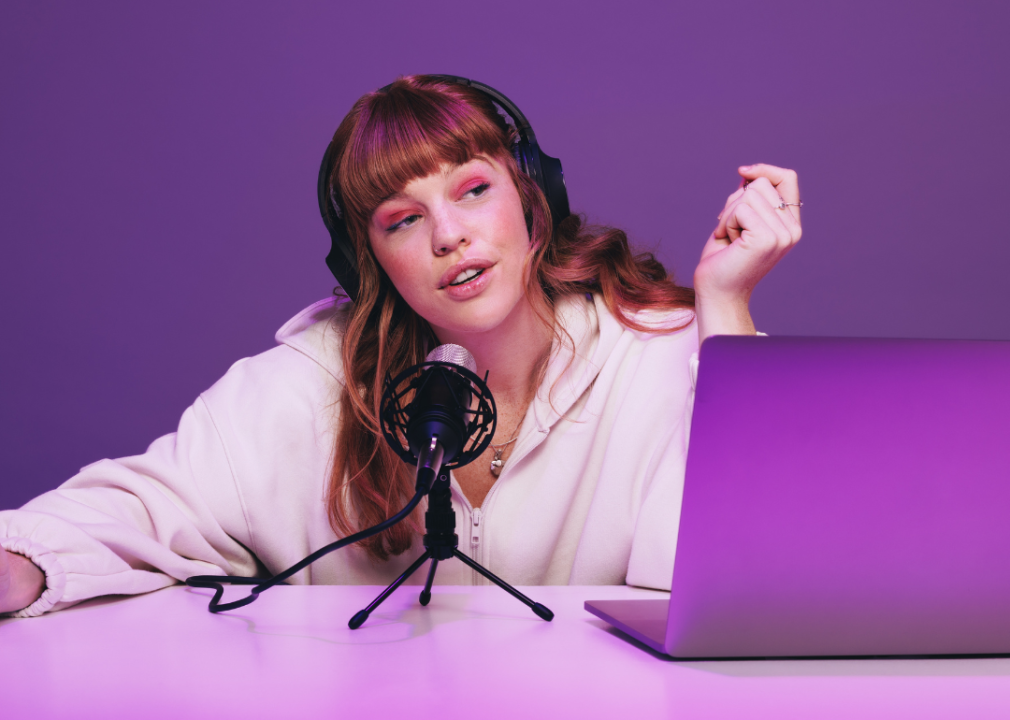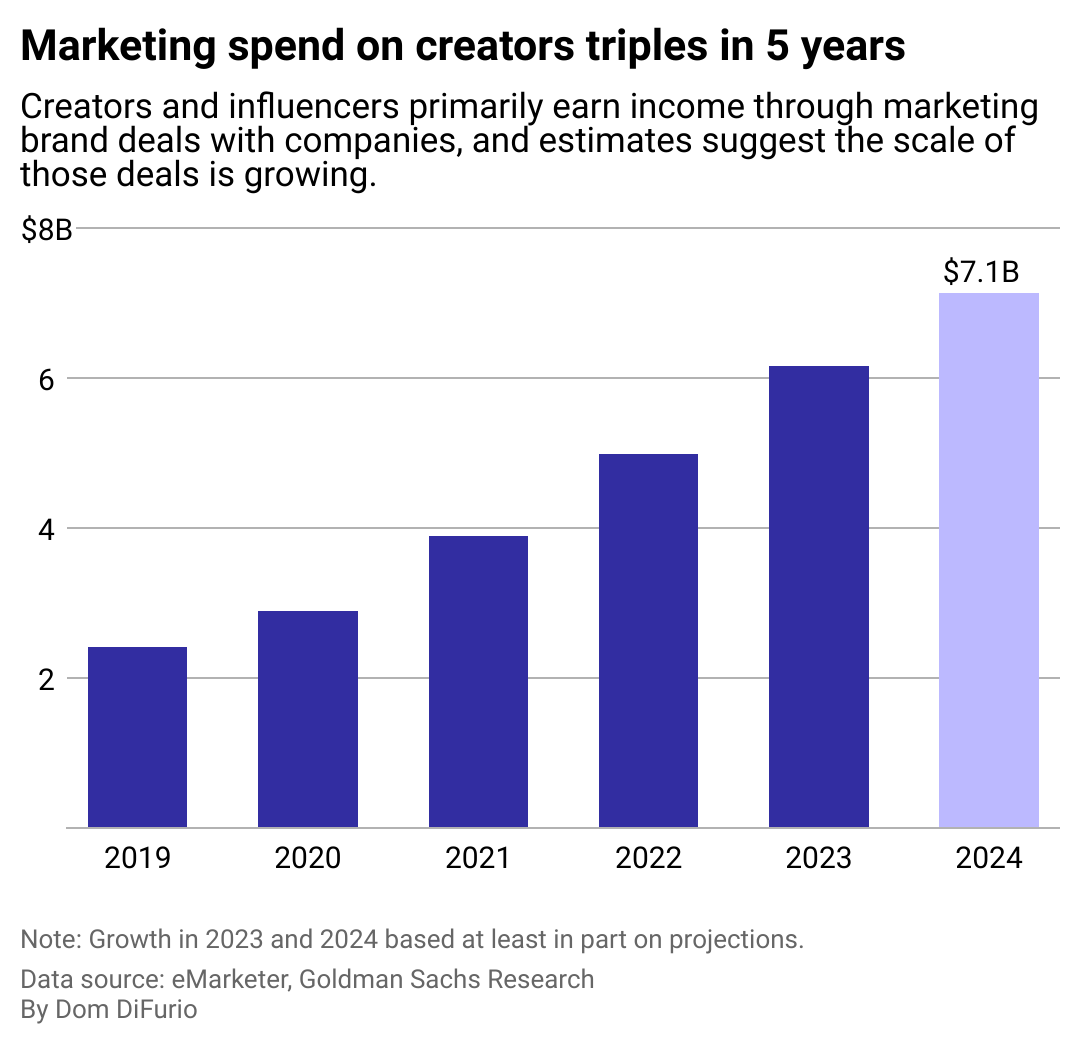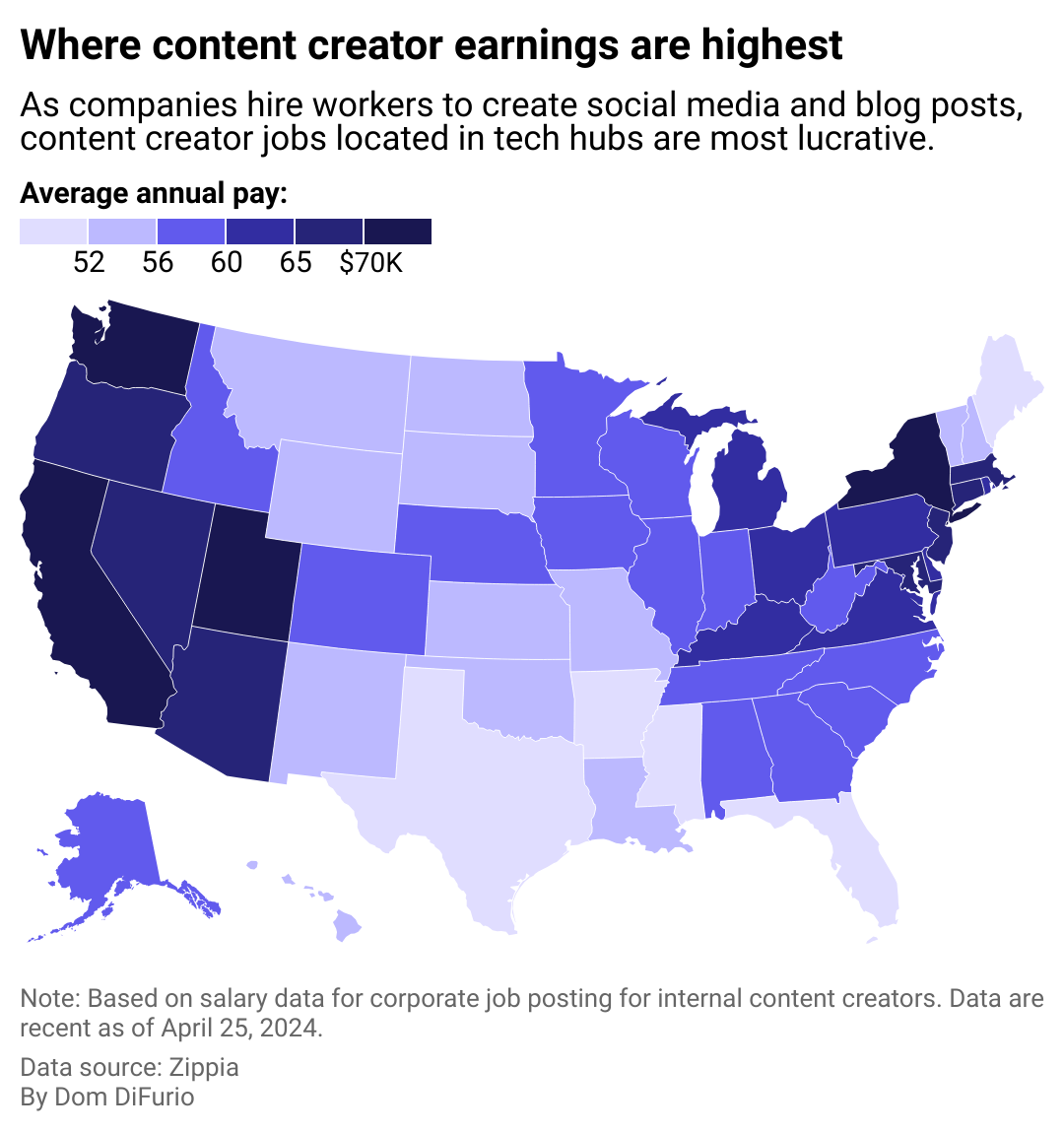The creator economy is worth an estimated $250 billion. Where is that money going?

Jacob Lund // Shutterstock
The creator economy is worth an estimated $250 billion. Where is that money going?
Podcaster recording an audio broadcast in neon purple light.
It’s been four years since social media darling Charli d’Amelio commandeered a dance created by Jalaiah Harmon and leveraged a seconds-long viral video into a multimillion-dollar personal brand, underscoring the fickle and often privilege-oriented nature of who succeeds and who doesn’t in the content creation industry.
But for every Charli d’Amelio, hundreds, if not thousands, of unknowns strive to share her throne. Each like, share, and comment doled out over hours of scrolling feeds this growing economy of workers—most of whom will never earn a living wage doing so. Still, they angle for influence and relevance across our screens.
Those workers are better known as content creators, now numbering at least in the tens of millions worldwide. Their ranks continue to grow each time someone produces a cooking video or a short sketch comedy in hopes they can garner enough engagement to propel them into a similarly lucrative gig.
Content creation has emerged as a formalized and desirable career, and companies have taken notice. The creator economy has further room to grow, with only an estimated 60% of the world on social media, according to an Al Jazeera analysis of DataReportal numbers—even as debates rage about social media’s risks. Companies, forecasted to invest even more in capitalizing on that attention, fuel a booming creator economy that rewards some more than others.
Collabstr analyzed research from Goldman Sachs and pay data from Zippia to illustrate the rapid growth of the creator economy and the earning potential of the creative people who power it.
Content creators can work independently or directly for companies. The term creator is sometimes used interchangeably with influencer, but marketers increasingly view them as distinct subsets of the marketing world. An influencer curates an image of themselves and their lifestyle to sell products or services or build brand loyalty. Accounts run by high-profile figures like Selena Gomez, Cristiano Ronaldo, and Kylie Jenner often overlap with a certain celebrity status.
Creators are typically entertainers whose main output is media that may or may not include themselves. Usually, it’s highly relevant to the niche interests of their specific audience. This category may include meme pages on Instagram and TikTok, and hosts of accounts focused on product reviews, like Justine Ezarik or MrBeast. The lines between these two kinds of creators are more blurred.
As the field has matured, companies are creating new roles that leverage creators’ skills. According to Deloitte analyst research, this line of work is poised for growth and could trigger a reckoning over working conditions similar to the gig economy.
![]()

Dom DiFurio // Collabstr
Have we reached peak influencer?
A bar chart showing the amount of money companies have spent on creator marketing in the past five years. In 2019 they spent $2.4 billion globally. That tripled by 2024, becoming $7.1 billion.
Put simply: No, we have not yet reached peak influencer.
Goldman Sachs analysts expect the share of marketing dollars spent on courting and retaining these professionals to nearly double by 2027, growing from $250 billion in 2023 to $480 billion. For these measurements, Goldman Sachs uses the term “creator economy” to reference both influencers and creators.
Estimates vary widely for the number of global contributors. Goldman Sachs places it at 50 million people worldwide, whereas Citi’s estimate is closer to 120 million, more than one-third of the entire U.S. population. In the U.S., the lifestyle of those working in content creation can vary greatly by region and brand deal availability.
If not associated with a particular brand full-time, the vast majority of creators’ income, around 70%, comes from brand deals, per Goldman Sachs. The creator shares advertorial videos or posts, with pay that typically scales based on their social media following. The symbiosis with existing industries fueled by the marriage of widespread smartphone ownership and social media marketing has led researchers at Deloitte to liken the creator economy to that of the gig economy, but for advertising.
Social media companies also pay creators a cut of their advertising revenue, though often at pennies on the dollar. Notably, some emerging platforms provide alternative routes to fund and support creators outside of advertising. Platforms like Patreon have emerged, allowing for paid subscriptions to fund creators’ work because the pay from ad revenue sharing is often meager.
In 2020, TikTok announced a multibillion-dollar creator fund that it shut down in December 2023. The fund was meant to compensate independent creators, although the company never provided details of the payments made or their size, and creators criticized the small payments they did see. It’s another example of how the billions flowing into the creator economy don’t always translate to higher earnings for the workers creating the content in our feeds.

Dom DiFurio // Collabstr
Few creators pull in lucrative incomes
A map of the U.S. showing the average content creator’s salary in every state. Washington is the highest-paying state on average for these workers, but generally coastal states offer higher earning potential. On the East Coast, New York and surrounding states offer the highest potential average earnings.
Until now, creators have been a largely unrepresented contingent of workers in trade unions and industry associations. However, that could change as media and advertising firms look to adopt more powerful artificial intelligence tools, according to Deloitte’s report.
On the heels of a dramatic summer of media strikes, which saw Hollywood actors and writers walk off sets for months, associations have popped up in the last year to advocate for their rights, including the Creators Guild of America. Established labor unions have also moved to recruit more creators as dues-paying members, a move that would give those workers access to things like health care benefits and perhaps even negotiating power down the road.
It’s an industry that oozes allure, with the most successful among the creator economy ranks sharing a window into the life of luxury some of them enjoy. Look no further than young people’s shifting career aspirations for proof of the industry’s glamorous sheen. According to regular surveys of Gen Zers by Morning Consult, more than half would become influencers if given the opportunity, citing the income, flexibility, and fun they perceive as part of the job.
However only about 4% of creators earn $100,000 or more annually, according to Goldman Sachs research. The average pay nationwide hovers around $62,000, according to a Zippia analysis of content creator job postings. A study from social media firm Linktree, which helps independent creators grow their following, shows a bleaker picture: more than 70% of creators earned less than $500 annually.
Even as the industry grows, Goldman Sachs expects the small proportion of high earners in relation to all creators to stay the same.
A highly competitive environment and limited opportunities to capture ad dollars may mean the next few years of growth will look similar to today’s creator economy. For another few years, the Charli d’Amelios of the world can capitalize on a viral moment to build out branded empires and feast while the next generation hustles for relevance on our social media feeds.
Story editing by Alizah Salario. Additional editing by Elisa Huang. Copy editing by Kristen Wegrzyn.
This story originally appeared on Collabstr and was produced and
distributed in partnership with Stacker Studio.
